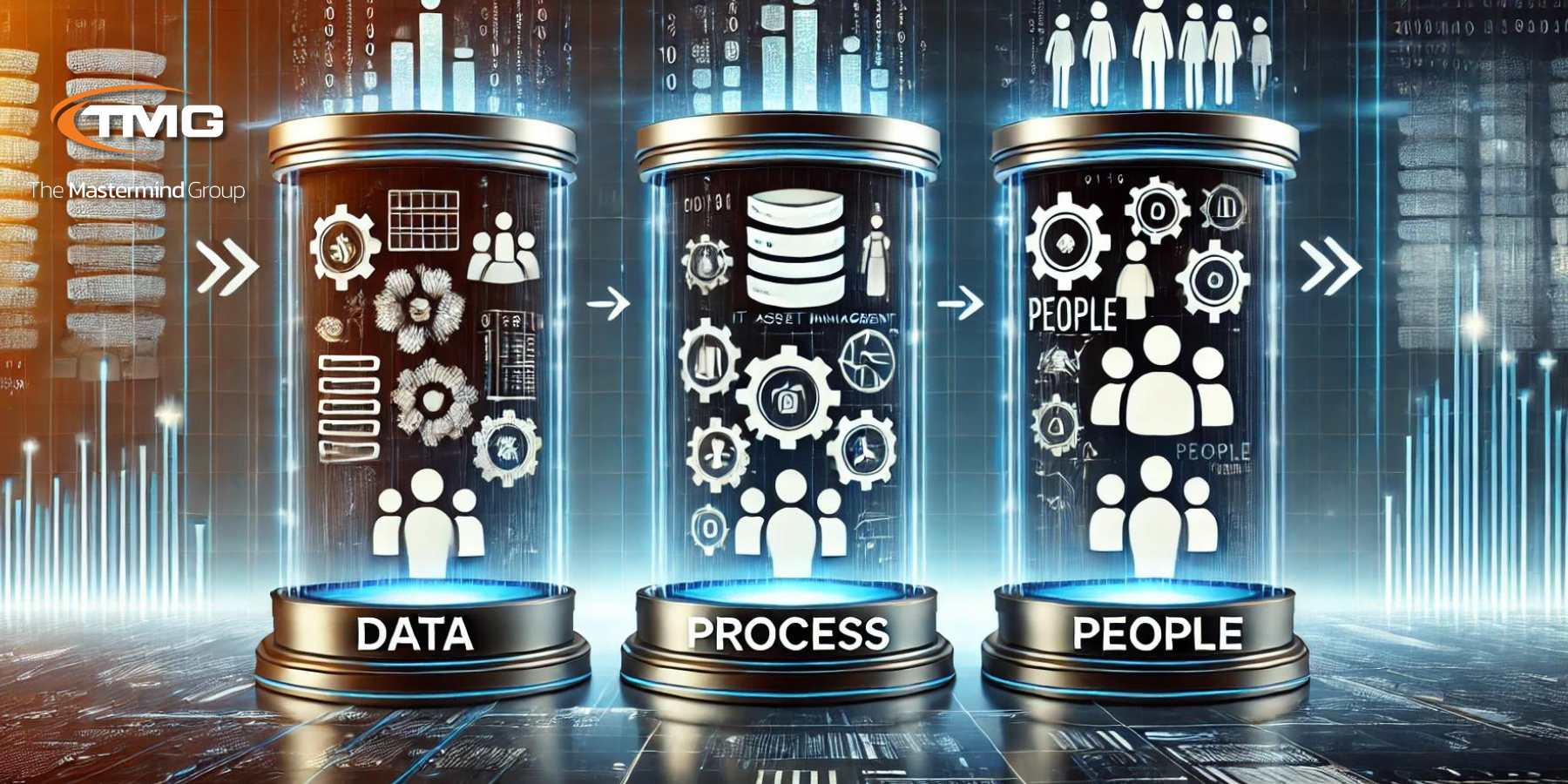Author: Michael Bottroff – Senior Data Analyst at The Mastermind Group
IT Asset Management (ITAM) is all about maximising the value of your organisation’s technology. However, achieving this goal requires a three-pillared approach: data, process and people. While data is often seen as the key to driving solutions, it’s only one piece of the puzzle.
Data: The Foundation
High-quality data is the bedrock of effective ITAM. Done well it can provide a clear picture of your entire IT environment – hardware, software, licenses – including their acquisition costs, utilisation, and lifecycle. This data empowers organisations to:
- Optimise Costs & Spend: Identify underutilised assets and negotiate better software licensing deals.
- Improve Security: Track vulnerabilities and ensure proper patching of software.
- Enhance Compliance: Demonstrate adherence to software licensing agreements and regulations.
ITAM data can then be used in conjunction with good processes.
Process: The Guide
Strong processes ensure data collection, analysis, and decision-making are consistent and efficient. This includes:
- Standardised Asset Discovery: Develop a system for accurately identifying and cataloging all IT assets.
- Automated Data Collection: Leverage technology to automate data collection where possible. Minimise your manual effort where you can; human error is real and unavoidable.
- Clear Policies and Procedures: Establish clear policies for software acquisition, licensing, and asset procurement and disposal. Avoid too many ‘exceptions’. Ensure your documentation is easy to understand.
However, data and process alone can’t solve all your ITAM challenges. Here’s where the human element comes in.
People: The biggest variable
People are often the biggest challenge for any ITAM program, particularly in larger organisations. We are all so different, from who we are, to the roles we play in our organisations.
- Varied Experiences: People come from diverse backgrounds and possess different levels of technical expertise. Some may be comfortable with new technology, while others may be apprehensive. This can lead to varying levels of adoption and resistance to change within the ITAM program.
- Differing Values: People prioritise different things. Some may value security above all else, while others might be more concerned with cost savings or operational efficiency. These differing values can lead to conflicting priorities and challenges in implementing ITAM policies that satisfy everyone.
- Competing Desires: Ultimately, people want different things from technology. Some may prioritise flexibility and personalisation, while others prefer clear guidelines and established procedures. This can create friction when designing ITAM processes that attempt to balance user needs with organisational objectives.
The impact on ITAM:
These human variables can significantly impact ITAM in several ways:
- Data Quality: User resistance to data collection and inaccurate data entry can compromise the quality of information used for ITAM decisions.
- Process Adoption: A lack of understanding or enthusiasm for new procedures can lead to people bypassing established ITAM workflows, creating inefficiencies and security risks.
- Stakeholder Alignment: Conflicting priorities and values within different departments can hinder buy-in for ITAM initiatives and lead to roadblocks in program implementation.
Stakeholder and executive buy-in:
ITAM initiatives require buy-in from key decision-makers. Without their support, securing resources and implementing changes becomes difficult.
Some ways to achieve this:
- Data Visualisation: Present complex data in an easy-to-understand format like charts and dashboards. This allows stakeholders to grasp the impact of ITAM initiatives quickly.
- Focus on Business Value: Translate data into clear business benefits. Show how ITAM saves money, improves security, or streamlines operations.
- Communication and Collaboration: Foster open communication between the ITAM team and stakeholders. Regularly update them on progress and address concerns.
- Thid-party validation: Obtaining a ‘2nd opinion’ from an experienced internal/external delivery partner can sometimes be critical in convincing leadership of the merit of your ideas.
Empowered ITAM team:
A skilled ITAM team can interpret data, identify trends, and propose actionable solutions. They also champion the program internally, promoting its benefits across departments.
All too often we hear about under resourced ITAM teams trying to do ‘everything’ and accomplishing very little. Lack of resources or support is often caused by poor executive buy-in (see above) and becomes a self-fulfilling prophecy.
- As leadership, you need to invest in and support your ITAM team.
- As the ITAM team you need to communicate to your leadership in language they understand and value.
Resistance to change:
People often resist change, especially when it comes to established workflows. Here are some strategies to address this reluctance and get people on board with your ITAM program
- Focus on the Benefits: People are more likely to embrace change if they understand the “what’s in it for me?” Highlight how ITAM will benefit them directly. This could be improved security, reduced risk of software audits, easier access to needed licenses, or streamlined IT support.
- Start Small and Build Momentum: Don’t overwhelm people with a complete overhaul. Begin with a pilot program in a specific department or with a manageable task, showcasing the positive impact before expanding. Success stories create momentum and encourage adoption.
- User Enablement: Streamline Tools, Training & Communication: Equip people with the knowledge and skills required to use the new ITAM processes and tools effectively. Communicate openly and regularly. Streamline the new procedures and tools to minimise burden on users.
- Foster User Buy-In: Address Concerns & Engage Champions: Listen to people’s concerns about the changes and address them head-on. Provide clear answers and offer support during the transition period. Identify and engage champions within different departments. These individuals can encourage adoption and address issues within their teams.
- Recognise Efforts & Celebrate Wins: Acknowledge and appreciate individuals who contribute to the success of the program. Take time to celebrate milestones and successes achieved through the ITAM program.
Some things to remember:
- Inclusive Design: Develop ITAM processes and tools that are user-friendly and cater to a wide range of technical abilities.
- Open Communication: Communicate openly about ITAM’s goals and benefits, addressing concerns and actively encouraging feedback from users with diverse perspectives.
- Targeted Training: Provide training tailored to different user needs and roles, ensuring everyone has the skills and knowledge to navigate the program effectively.
- Building Relationships: Foster strong relationships with stakeholders across departments, building trust and seeking collaborative solutions to address their diverse needs.
- ITAM is not Everything: ITAM is critical, and it’s likely the focus of what you are trying to do. However, remember and understand that everyone has their own job to do, with their own outcomes and benefits for the business. Consider how ITAM aligns with your organisations core business purpose and principles, and how it impacts the people you are wanting to adopt it.
People are the heart of any successful ITAM program.
Acknowledging their diverse experiences, values, and goals is crucial. By bridging the gap between data, process, and user needs, organisations can build a more effective and sustainable ITAM program.
This can be achieved by focusing on the benefits for users, providing support, and addressing their concerns. Overcoming user resistance fosters a culture of collaboration around ITAM. Remember, successful change management is about creating a positive user experience.
Ultimately, success lies in striking a balance between data, people, and process. Data provides insights, people champion the program, and processes ensure efficient execution. It’s not just about the data; it’s about using it to empower people and guide effective processes for a thriving IT Asset Management program.
Author: Michael Bottroff – Senior Data Analyst at The Mastermind Group

